Run, David, run: the Red Queen stalks MONA
Welcome to Hobart
A beam of white light props up the dark winter clouds above Hobart. Bonfires along the harbour’s warehouses give some heat to the groups of people eating, drinking and listening to music. A flameburst in the sky above briefly outlines a mess of what looks like distended udders wrapped around a hot-air balloon – and then gone. This is Dark Mofo, Hobart’s winter festival, warming the hearts of locals, tourists, taxi drivers, restaurateurs, tourist agencies, city aldermen and Jet Star accountants alike. This is arts-led urban regeneration redux.
Dark Mofo is the hibernal sibling of Mona Foma – the Museum of Old and New Art’s summer Festival of Music and Art, Tasmania’s largest contemporary music festival. First run in the island state’s capital Hobart in 2009, its eclectic mix was an early indication of the ambitions of the relatively unknown Moorilla Museum of Antiquities, which had closed its doors in 2006 for a refit. The refit took five years and about $75 million, and was the personal vision of local hero and gambling millionaire David Walsh. As Nonda Katsalidis’s building was being sunk deep into the rock below the heritage-listed former home designed by modernist architect Roy Grounds, Walsh’s encounter with modern and contemporary art accelerated. In 2011 a new kind of iconic building – apart, mysterious, dark and Delphic – surfaced beside the River Derwent, 30 minutes by ferry from Hobart’s docks.[1]
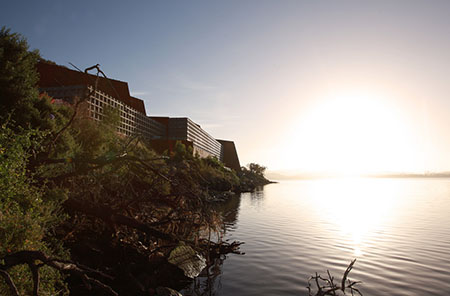
photograph by Leigh Carmichael, MONA Museum of Old and New Art, Hobart, Tasmania, Australia
Brimming with an astounding private collection of antiquities and modernities, Walsh’s MONA was a private folly, a personal obsession made public at his own expense, and set to cause outrage, or at least indifference, among the people of Hobart. Last stop before Antarctica, global birthplace of the Greens, Australia’s most economically challenged state, Tasmania – unlike Bilbao’s strategic Guggenheim – was home to MONA only because Walsh happened to be born there. The museum was an instant, surprise hit, not just locally but across Australia – MONA’s media manager has a scrapbook bulging with feature articles from across the globe.
At first glance, 2007 appeared a bad time to start a regeneration project. After two decades, the bright global urban future that was to have been kick-started by a heady combination of starchitecture, startists and the ready availability of coffee, had now juddered to a halt. The regenerative effect of catering to the consumption preferences of the creative class – once a truth universally acknowledged –was now unstuck, as its academic-entrepreneurial proponent Richard Florida admitted his central claims were essentially flawed. The creative city had become a hubristic ruin, belonging to that other world, before the global financial crisis.
Yet here in Hobart we have the arts-led – not just culture-led but arts-led – regeneration in its classic form: the arrival of a multimillion-dollar art gallery transforms the capital of Australia’s most economically marginal state. According to some in local and state government, Tasmania (or at least Hobart) is headed for a new golden age. Others are more sceptical – such as Prime Minister Tony Abbott, who during the federal elections suggested chopping down trees for pulp, not a ‘restaurant-led economy’, was the way forward. But let’s assume that the reason for the 40 per cent rise in Qantas flights to Tasmania, for the rise in the numbers of bars, restaurants, hotel rooms and cultural events, lies with the more than 350,000 visits made annually to MONA. Whatever synergies are being developed between Hobart Council and MONA – Dark Mofo was just the beginning of some exciting mutual explorations – and however the strange new value presented by MONA is to be understood and handled by state and city, it is the energies opened up by David Walsh’s art collection and building that are at the heart of everything.
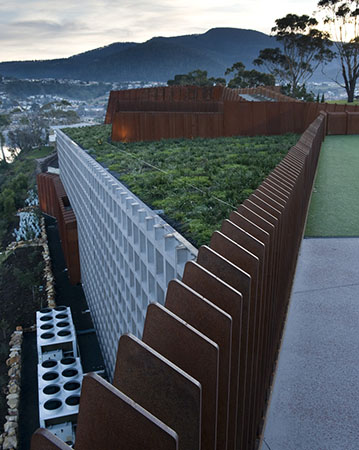
photograph by Matt Newton, MONA Museum of Old and New Art, Hobart, Tasmania, Australia
What are we to make of MONA? Hailed as the democratisation of the gallery, it is privately owned; hailed as demystifying art in the name of popular culture, it presents the arcane darkness of old and new art in a ‘cathedral’ or ‘shrine’; hailed as accessible to those who have never been to an art gallery, it has five-star accommodation, an expensive restaurant and regularly hosts the glamorous, the great and the good from the arts world. These apparent contradictions are not hypocrisies or scams; or if they are, they are self-consciously so. When people discuss the Guggenheim in Bilbao they talk of its architecture and its gentrification effects. MONA is discussed in terms of the pilgrimage-like experience of the journey, the theatrical staging of its collection,[2] and the odd rubbishing and recycling of the ‘sacred’, long cleared away from public galleries.
A question many people openly ponder is whether MONA will be absorbed, rerouted by commerce, real estate and political correctness. The less pondered question is whether MONA will be absorbed or rerouted by the art world. What kind of new, equivocal space has Walsh opened up beneath the cliffs of the Berriedale Peninsula? It costs $8 million a year to run; but for how long can it really remain open?
Art wank
The background to MONA is so well-rehearsed it has become a local and national legend. Working-class Hobart lad, sort of a geek, sort of underachieves at school and uni, leverages his mild Asperger’s-driven love of maths into a gambling system and bang: millionaire! But no girls, cars, drugs, and Sydney shoreside McMansions for David Walsh (ok, no McMansions then). He bumped into art. Was this a legitimation strategy, giving respectability to ill-gotten gains? Or the classic ploy of the self-made man desperate to gain entry to the ranks of the great and the good?
In some ways he was the archetypal collector: an initial accidental acquisition, a couple of follow-ups, hints of an obsession, emergent autodidacticism, growing rumours among expert buyers, head-turning splashes in the serious art market, overflowing house, garage and lock-up, purpose-built museum. But this collector remains the sceptical outsider, his interest driven by his very scepticism. The art world is not a cathedral with foundations deep in the soil of western culture; it’s a flimsy sham, a world of fakes and fronts, fakirs and arty wankers. A world where value – big money – is whisked up from nothing, where shoving this very nothing right in people’s faces makes them howl with pleasure and pay for more. But why so? The very flimsy-ness of the art world, an insubstantial pageant of the flaky, fucked-up and fantastic, is something that needs to be accounted for. Yet MONA’s irreverence was not an attempt to demystify this art world but to restage the puzzle, the affront, the sheer improbability of art.
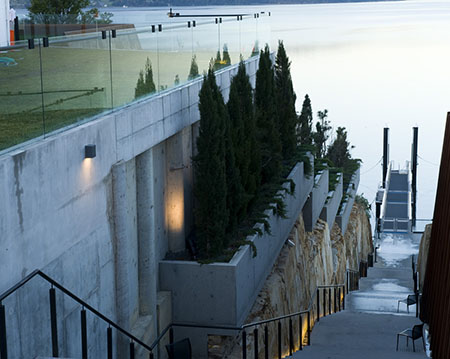
photograph by Matt Newton, MONA Museum of Old and New Art, Hobart, Tasmania, Australia
Part of the legend of MONA is its scant regard for the pieties of the established art world and especially the big public galleries. There are no labels on the wall; there is the ‘O system’ instead (an audioguide in the straightlaced language of public galleries). This has sections entitled ‘art wank’ and ‘gonzo’. There are wacky interviews and home-brewed rock/ pop, and, yes, it looks like an iphone and you can ‘like’ and ‘dislike’ stuff, and save your tour to your email for later. The irreverence, the rejection of didacticism, the nods to mobile co-creative social media, are mostly taken to mean the democratisation of art. This everybody tells you. And this, of course, has been the holy grail of public art galleries in the last few decades. They began with making galleries less austere and off-putting; make the visitors welcome, make the information accessible, open a cafe. Soon it meant putting things on display that people actually might want to see and in ways they might want to see them. This produced many taut, innovative and fascinating exhibitions. It also produced ‘interactive’ bells and whistles, exhibitions indistinguishable from shopping malls, and museums so accessible that visitors could wander through barely realising that they had, in fact, accessed anything at all. The irreverence at MONA, I would say, is not an index of its accessibility but rather an exuberant dance in the strobe-lit ambiguity of a clothed/naked emperor. It takes the scandal, the scam that is art very seriously indeed.
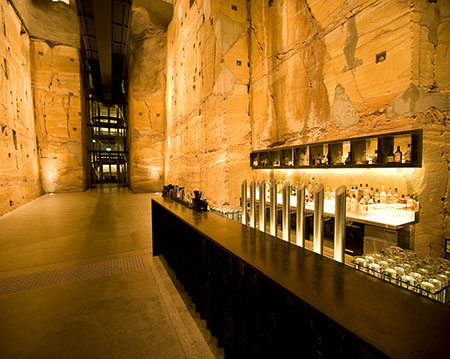
photograph by Matt Newton, MONA Museum of Old and New Art, Hobart, Tasmania, Australia
The first line of Adorno’s Aesthetic Theory goes: ‘It is self-evident that nothing concerning art is self-evident anymore, not its inner life, not its relation to the world, not even its right to exist’.[3] For Adorno, art stood in some impossible space between rampant commodification and the totally administered society. For David Walsh and MONA – and for the moment, let us assume that the latter grows out of the former – the impossible space of art is not social but biological, evolutionary, genetic. The bookshelf at MONA is interesting. Half of it has the usual monographs on artists and catalogues of various exhibitions. The other half – where you might expect cultural studies, or feminism, or Deleuze and Guatarri – is made up of books on biology, evolutionary theory, sociobiology and militant atheism. In interviews and written pieces David Walsh has stressed his atheism and his radical evolutionary materialism. We are – in our behaviour, our perception, our desires – the product of millions of years of evolution, especially our long-term sojourn on the plains of Africa, waiting for the Holocene to happen. As he noted on ABC radio early in 2013, Walsh would shed no tears for the extinction of the human species. ‘The earth will cope with our accidental malicious intervention and invent a new bio-sphere; it just might not be suitable for us’.[4] As the post-humanities like to tell us, we are non-teleological, singularities, pure happenstance. But, unlike the great militant destroyer of the faith, Richard Dawkins, who would not give it a micro-moment’s thought, Walsh is drawn to the oddity, the anomaly of art. What on earth is it for? What function does it perform? Why should anyone like it or find it remotely interesting?
Sex and death
Richard Dawkins can show that religion is nonsense, and that it is responsible for untold suffering down the ages. What he can’t explain is why we ever needed it in the first place and worse, why we cling to it when there are scientists like him around. David Walsh is drawn to the question, as can be ascertained from an attentive listen to the O system. Though many people tell you that MONA is not didactic or pedagogical, this is clearly not true unless you choose not to listen (a minor revolt, like not reading the labels). There is a set of messages here. They are not to be found in ‘art wank’, which contains some basic facts about the work in question, sometimes a snippet of biography, or the background to the acquisition. More of this can also be found under the music/ sound tab, containing interviews with the artist in question by MONA curators. It is under ‘gonzo’ (‘What’s a gonzo?’ I overheard a senior citizen ask her partner, indicating the odd ways in which social exclusion works) that we get David Walsh’s take on things. There are some straight-out jokes and the tone is modest and self-deprecating. But under the irreverent bonhomie there is a clear sense that if art is to be anything other than sanctimonious cant and disavowal, it has to relate to the deepest fears and desires of the human animal. We seek to reproduce and to ensure that our offspring survive. Sex and death.
Much has been made of MONA as Sex-and-Death, often by Walsh himself,[5] though he now thinks this aspect is overplayed. The theme clearly lends itself to the MONA of black leather and Goth, of glamorous self-destruction, of rock and roll – and it makes it such a great companion to the successful music festivals that are part of the MONA brand. Much too has been made of the theatrical, even the operatic, aspects of MONA. It is a space apart, revealing itself only to those who enter its underground portals – unlike those other iconic glass and titanium bimbos of urban regeneration – and the artworks are displayed and lit as if on a stage. Often a very private stage, as in the case of the room with the mummy and the dark water, where only ones and twos are allowed. The rejection of labels is not anti-didactic but aesthetic – they ruin the moment. MONA is staging an anthropological encounter, but not with the archaic past. In the classic 19th-century museum, especially as dissected by Tony Bennett, this past is one from which we safely escaped and we luxuriate in the great progress we have made.[6] MONA’s archaic past, like the core biological systems we inherited from our aquatic ancestors (fascinating accounts of which can be found in the MONA bookshop), is still with us. Sex and death are still with us, all around us; it is just that our everyday life, our self-delusion, hides this from us.
Art – the best art – takes us back to it. Walsh, the militant atheist, adapts the idea of the sacred as a space apart, a ‘secular temple’ where we can confront these foundational questions of human existence. This is not Alan Bennett on a spare afternoon in Leeds Art Gallery, or Philip Larkin wandering into an old, empty church; it is a Delphic shrine, a place we set out for, set time aside for, a destination (if we can retrieve that word from the zombie language of the tourist agencies). We expect to encounter the mysteries. Art here is not the spiritual transcendent but the evolutionary biological, the relentlessly material. Art is peacocks’ feathers, a display of ‘excess capacity’: useless (and often debilitating) for anything other than getting a mate. ‘I am doing this to make me look clever and make you fancy me.’ Art has other uses, as he tells us in the ABC interview. It is about narratives, and telling stories creates plans, fictive futures, optionality. It helps us in exploring possibilities: ‘This clearly has a survival basis ... creativity increases survivability – using narrative is an evolutionary compulsion.’ But our ‘excess capacity’ takes us to places perhaps we were not intended to go, to cognitively explore places not created by evolution, such as quantum mechanics. It brings us consciousness of death and of 1.2 billion years of history, which may or may not have needed cognitive being such as us to acknowledge it.
‘One day’, Matt Ridley promises us in his 1993 book The Red Queen, ‘some scientist will know exactly how the brain of a young man becomes obsessed by the image of a particular young woman, molecule by molecule’.[7] This is not the world of David Walsh. The art that he would find interesting would be about what it might be like to live in a world in which we knew molecule by molecule what it felt like to fall in love. The art assembled by MONA, the story told about it, is peacocks’ feathers, complicit in some molecular chain of bluff and desire; but there is also an excess of self-consciousness coupled with a wilful refusal to disavow this hard knowledge. MONA presents us with an art working at the limits of sex, death and hard-eyed scientific knowledge about sex and death, and in a way that stages how our experience might be lived and accepted in full acknowledgement of this.
Art, enlightenment, government
In some respects MONA’s take on this reinvents that hoary old Kantianism, the uselessness of the aesthetic. Matt Ridley again: ‘A peacock is a showy peacock because at some point in history ancestral peahens stopped picking their mates according to mundane utilitarian criteria and instead began to follow a fashion for preferring elaborate display’.[8] Perhaps this is more Bourdieusian: the disinterested display for its own sake indicates that I have the strength and the breeding (the evolutionary capital) that you really want. But there is more. In art there also is a useless knowledge, a heavy, potentially debilitating knowledge, which can be disavowed or accepted with clear eyes and a light heart. Less the dour atheistic puritanism of Richard Dawkins and more a Nietzschean yes-saying to the world of sex and death and our full, scandalous, useless awareness of it.
Tony Bennett dismisses the uselessness of the aesthetic, arguing repeatedly that art and culture have been all too useful to governments at home and abroad (especially in its colonial encounters).[9] There is no ontologically distinct sphere of culture, such as the symbolic or, God forbid, mind or spirit. Culture is one mode, one surface by which governments work on ‘the social’. The democratisation of art can only mean the extension of its mode of governmentality to ever wider circles of the population. Museums and galleries – intended to civilise the new urban masses, or create national and/or racial subjects – are now called upon to deliver new messages, to realign the contemporary subject in ways that suit our current preoccupations – multiculturalism, tolerance, diversity, cosmopolitan citizenship.
Paradoxically it is a museum that completely ignores such useful governmentality, one that re-activates the sacred space of an art apart, that is now hailed as the most democratic. Behind the state-of-the-art visitor hospitality, the music-business branding, the interactive guides, MONA speaks to grownups, to their fears and desires, to the anxious awareness and evasions of experience. It does what art – the best art – has done since Kant: its uselessness questions that which we consider useful.
David Walsh explicitly sets MONA against government.
A state museum is an engagement in certainty, protects the belief of the state, what good taste is: ‘enter our portals and be enlightened’. So that’s essentially autocracy and we are essentially anarchic, we give you the capacity to form your own opinions. And we are so uncertain, we engage so obviously in doubt, that you are empowered because if we don’t know what we are talking about why should you be worried about being wrong or ill-informed ...I feel I give people the right to form an opinion.
This sets the doubtful, sceptical methods of science (which yet extracts reality, such as the elegant truths of mathematics and genetics, from the world) against the dark forces of autocracy. Revelation and certainty do have a function – ‘armies of conquest need unity of belief’. It is not that the best lack all conviction; just that getting the curious, the sceptical and the scientific to act together is ‘like herding cats’. So MONA is to be a ‘mausoleum of curiosity’ where people are not given certainty but the respect and the space to make up their own minds. Rather than the dumbed down interactivity and accessibility of contemporary cultural policy-speak, this is a restated belief in active, self-reliant democratic citizenship. This is enlightenment, but less Sarastro than Walt Whitman.
The Red Queen
At the heart of Dark Mofo and its crimson brand coherence was the opening of the new exhibition, The Red Queen. Walsh’s collection was first assembled in the 2011 exhibition Monanism. One of the MONA team’s many great puns, the core collection highlighted sex and death, dysfunction and excess capacity – and the daily scam/business of the art world. Its theatrical presentation and lack of chronological ordering led many to see it as a Wunderkabinett: the collapse of the modernist narrative of progress signifying not just the random caprice of the anti-academic collector but the freeing of objects from the burden of a singular narrative. But it is hard to see how such a collection of old and new art, presented in such a way, could be characterised as ‘cabinet of curiosities’; though not a chronological narrative the exhibition was much more coherent than such cabinets.
Theatre of the World, MONA’s third exhibition and currently out touring, might have been seen as a globalised Wunderkabinett, but again it was more than this. It was curated with the help of Jean-Hubert Martin, whose show at the Pompidou Centre, Magiciens de la Terre, had both broken the exclusive hold of the Eurocentric narrative of art history, and also drawn non-Europeans into the global art world. Theatre of the World might be seen more as a kind of Levi-Straussian search for crosscultural patterns reinterpreted through evolutionary biology. The archaic and the contemporary are co-present, paper-thin additions to the deep evolutionary history of which we are the living result. Picasso’s masks, tribal masks, minimalism and religious rites – these express our evolutionary humanity already honed by the time of the Holocene.
Alice looked round her in great surprise. ‘Why, I do believe we’ve been under this tree the whole time! Everything’s just as it was!’ ‘Of course it is,’ said the Queen, ‘what would you have it?’
The Red Queen, a ‘logical progression from Monanism’ is curated by Nicole Durling and Olivier Varenne, responding to the ideas of David Walsh.[10] The description on the MONA exhibition website tells us that Lewis Carroll’s Red Queen was adopted by evolutionary biology to show how any new competitive edge a species develops is soon whittled away by the rest of the environment catching up with it.
That notion – that one might run and run, with neither goal nor end – is one key to twenty-first century thinking about how species evolve, in brutal harmony, with their environment. We’re not used to thinking of it like that. We like to imagine we are struggling ever-forward to some end-point – personal, collective, universal – that will atone for our suffering and make our joys mean something. Evolution has no such agenda, nothing in mind for us, as it molds us to the shape of our environment. When you look at it like this, and surrender the assumption of progress, all of a sudden our words and deeds – like the Red Queen’s – mean nothing and everything at once; rich and strange nonsense indeed. How does art fit into this? It is a behavior, a practice, that congeals humanity like the fat in a fry-pan; it clarifies and distills, evaporates the excess, until we can see (just for a moment) into the base of ourselves.[11]
This is a 21st-century sociobiological Nietzscheanism, with hints of Bataille and Beckett. Its puncturing of progress with its (false) salvation reminds us of Walter Benjamin’s radical rejection of the illusions of historical materialism and the need to face up to the possibilities and potential of the ‘nowtime’.[12] But in this formulation there is no ‘brushing history against the grain’ because there is no history, just an eternal return of the same. Varenne tells us, ‘We thought that the motivations of artists today would maybe be the same as the motivations of artists 20,000 years ago. The words were different, the politics were different, but the deep emotions would be the same’.[13]
Here, it seems to me, is the nub of the problem. The abolition of history – not just its teleology but meaningful historical change per se – can only lead to myth. There are two mythologies at work in MONA, one more visible than the other, and both are threats to its enterprise, in my view.
Eternal art
Varenne again:
Why is art all over the world? In every culture in the world it is constant, in every civilization, in every tribe. Some art is better than another one but this is not what we are really trying to discuss; it’s how come there’s so much art. Since the beginning of humanity art exists.[14]
Durling takes her cue. ‘As soon as humans have food and shelter, they start creating in whatever form that is, whether it is dance or music or drawing pictures in the sand. Personally, I’d be happy if visitors come in and start thinking about what is creativity or what part of them is creative.’[15]
The problem here is not just the banal recycling of Maslow’s ‘hierarchy of needs’ – if they start creating only after food and shelter then what happens to the whole peacocks’ feathers and evolutionary compulsion to narrate thesis? Nor is it the dispiriting injunction to search for your own creativity. It is the idea of eternal art; that the artefacts of ritual, religion, pleasure, recording, communication and so on can all be brought under the heading ‘art’. This is a return to a high modernism of a Greenberg or Malraux; we now recognise as art what was buried in these other uses but, suitably scrubbed up and re-lit, they can now be seen as essential artistic expressions of our common humanity. And as befits an art world predicated on the values that can be established by the auction house, it is accepted as obvious that ‘some art is better than another one’. The scandalous, precarious existence of art that pervades Monanism is in danger of solidifying – congealing – into an eternal attribute of humanity. The question ‘Why art?’ asked under threat of its possible disappearance then becomes ‘Why art?’ asked before an eternal enigma with the mythical solidarity of an Easter Island moai.
The immediate outcome is to turn The Red Queen’s questions into a banal philosophising in which any artwork, whatever it is, can be turned into a reflection on the nature of art as such. To make a trip around the exhibition with the O system is to experience a radical disjunction between eyes and ears, between an encounter with the artworks and the narrative or explanatory structure in which they are embedded. It is a disjunction or a forcing worthy of the most didactic museums. Two examples stood out for me.
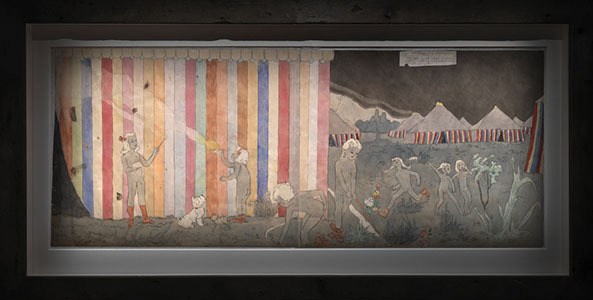
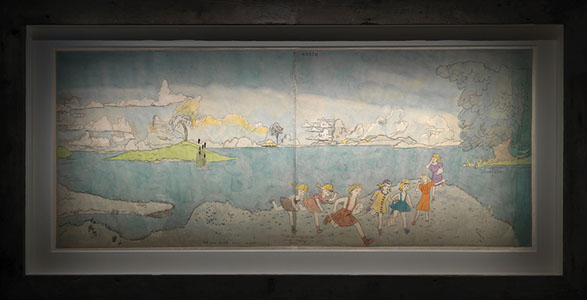
by Henry Darger (1892–1973)
photograph by Rémi Chauvin, MONA Museum of Old and New Art, Hobart, Tasmania, Australia
A room given over to selections from Henry Darger’s The Story of the Vivian Girls – disturbing ‘outsider art’ part sci-fi comic strip, part children’s book, part torture-porn, made in solitude and undiscovered until after his death – is held to raise questions about why we make art if there is no audience. The O system brushes aside the paragraph on his biography and possible motivations:
More useful to us ... are questions about the nature of art-making – or indeed, humanity itself – engendered by the pieces of himself he left behind. Explicitly, at what point does an act of self-expression alchemise with its environment to ascend to the status of ‘art’? ... Does the trait (of making art) confer specific social (including sexual) benefits and, if so, how can we account for an artist like Darger – a man who thoroughly eschewed the rich potential for status through art making.[16]
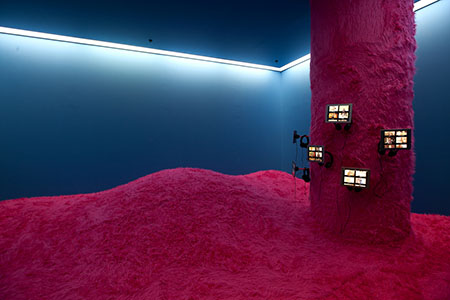
by Kutluğ Ataman (born 1961, Istanbul, Turkey)
24-channel video installation
photograph by Rémi Chauvin, MONA Museum of Old and New Art, Hobart, Tasmania, Australia
A room full of talking heads on old TV sets in front of ‘shitty’ couches – Kuba by Kutlug Ataman – featured residents of the eponymous shantytown near Istanbul airport. As Adrian Searle described it in The Guardian:
The longer you listen, and the more you meander from chair to chair, the more you gather that these stories are entwined, in betrothals and blood feuds, jail-time and dead time, which the unemployed men spend in makeshift coffee houses, the women stuck with their kids, or waiting outside the prisons for their husbands’ return. Sometimes, they don’t come back.[17]
As Elizabeth Pearce, one of the MONA team, notes on the O system, the sociopolitical intent of the piece, showing the ‘beatings, poverty and disappointments’ of Kuba, is supported by Ataman’s own time spent in jail for ‘unspecified left-wing activities’. Kuba is set next to Ataman’s Paradise, sited in the ‘pink fluffy comfort’ of the adjoining room, full of the voices of the ‘eccentric, indulgent privilege of Orange County’. But Pearce tells us she’s not swayed by sociopolitical reading, refuses the ‘stereotypes’ on offer and says they are all individuals, and they are all ‘abstracting themselves – using symbols to transcend the facts of their flesh. Writing themselves as story’.
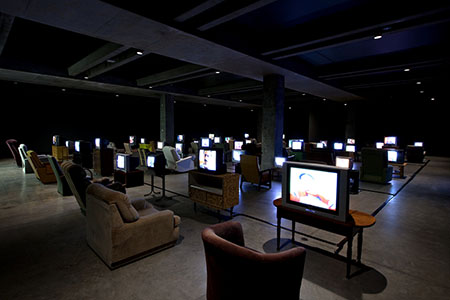
by Kutluğ Ataman (born 1961, Istanbul, Turkey)
40-monitor video installation, site-specific installation commissioned by MONA for The Red Queen
photograph by Rémi Chauvin, MONA Museum of Old and New Art, Hobart, Tasmania, Australia
So the clear sociopolitical message is refused and all are simply individuals ‘abstracting themselves’. Ataman is quoted by Pearce: ‘Talking is the only meaningful activity we are capable of’; from a left-wing activist making a piece on suffering slum dwellers this has clearly a different meaning than what Pearce makes of it. That is, an extended riff on evolutionary psychologist Geoffrey Miller, who claims that many of the traits fundamental to human kind come via the mechanism of sexual selection. As Peace summarises: ‘amusing arresting talkers got more men/ women – and perpetuated more arresting-talk genes – than boring mumblers’. (She doesn’t consider that there might have been rapists with clubs). At the end of this she concludes: ‘I’m a writer, but also a reader, a person, and a lover. And talk to me is paradise’. Which clearly puts her in the pink fluffy room leaving those waiting for their disappeared husbands to get on with the job of abstracting themselves.
Jean-Paul Sartre once described Albert Camus’ writing style in The Outsider as looking at a conversation in a phone box: we can see the gestures and the mouth moving but have no idea as to the meaningful content of what is going on inside. Here we have people coaxed with great difficulty by Ataman into speaking to us, but the curator gently shuts the glass door and enjoys her reflections on the nature of evolutionary humanity.
The exhibition continually shoehorns the artworks into the overall theme. Part of the problem is that there are simply not enough archaeological or scientific contexts presented to make this a real exploration of the question. The theme is merely a peg on which to hang curatorial riffs – the whimsical, the oblique and the idiotic. But the real problem is that commissioning artists to make work about ‘what is art’ is usually pretty banal, made more so when done in terms of a scientific hypothesis far from their field of expertise. Art asks the question, ‘What is art?’ when it pursues its own enquiries along the borders of its own impossibility, where it skirts disintegration and disappearance, which is precisely what so much of Monanism felt like. Not only does The Red Queen consistently miss its mark, it reinstates art as an eternal.
But it can be worse than that. It reinstates the art world.
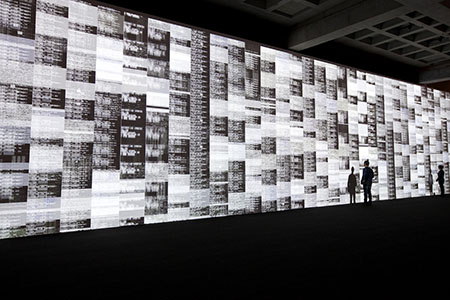
by Ryoji Ikeda (born 1966, Gifu, Japan)
three digital light processing (DLP) projectors, computers, speakers, edition of two plus one artist proof
photograph by Rémi Chauvin, MONA Museum of Old and New Art, Hobart, Tasmania, Australia
What for me was one of the highlights of the exhibition, data.tron by Ryoji Ikeda (who also did the beam of light, Spectra), was accompanied on the O system by a rambling account of a (non-) interview with the artist, along with champagne, complaints about Olivier Varenne getting to have a penthouse apartment, and other bits of froth worthy of Hello! magazine. The irreverence of David Walsh turned into narcissistic art world hedonism. Popping out from behind the anarchism, the world of private viewings, private auctions, private jets. The art world lifestyle: one that most state museum curators, slogging through a pile of compliance documentation, would find difficult to afford on their ‘efficiency dividend’ salaries. The democratisation of art becoming an escape from the Scylla of the state, just before its plunge into the Charybdis of Sotheby’s and Christie’s.
... and the end of history
History, the real history of the here and now, including that of the global circuit of money, people and objects that flow through the contemporary gallery, is effaced under the eternal presence of art. The problem is not just that a specific category of the late 18th century – ‘art’ – is extended to all times, all people, all places. Post-Sumerian history has collapsed under the dead weight of 1.2 billion years of evolution. If modernity is a mere ‘sh’ of a flash in the pan, attempts to assert ‘culture’ or ‘morality’ or indeed ‘progress’ against our genetic hardwiring can only be risible illusions.
There is no doubt as to the new insights opened up by the real interdisciplinary cross-fertilisation of genetics, biology, archaeology and historical anthropology in the last 50 years. However, when such insights are used to dismiss the relevance of history, things quickly revert to myth. The links between sociobiology and the new agenda of neoliberalism in the 1970s are hard to deny. The Red Queen, as we have seen, is also the title of a book by Matt Ridley, who – as sacked director of the failed (and taxpayer-bailed) Northern Rock Building Society, David Cameron-appointed member of the House of Lords, climate-change denier and all-round supporter of the core tenets of neo-liberalism – has a very clear political agenda.[18] The 1960s, and the cultural and psychoanalytical gurus, who saw humanity as changeable are directly refuted by the findings of science. Inequalities of power and income – along with the cars, the girls, the penthouses – have always been with us and so they shall remain. If we have progressed materially it is because we have worked with this, most particularly in the area of the free exchange of ideas, which is homologous with the free exchange of market commodities, which is homologous with the free exchange of genetic material in the competitive environment that is evolution. Neoliberalism is coded into our DNA.
Walsh says in the ABC interview with Phillip Adams that he was shocked when people weren’t shocked by MONA. How is it that his anarchistic frontal assault on autocracy was met with open arms by the city and state government, and the great and powerful generally?[19] Might it be that the dark powers no longer need history and are happy with sex, death, money and power – and an art world that celebrates these?
After flinging a pot of something nastier and more viscous than paint in the face of the local public, Walsh tells us that local people responded warmly, took ownership of MONA, made it their own, and wrote him moving personal notes. He did not expect to care, but he does. The human species can go under perhaps but not Hobart and MONA, metres from the rising sea level. In a way that would please the theorists of the ‘more-than-human’ Walsh calls 1.2 billion years of life on earth ‘history’. His anxieties and interests are around the improbability of human consciousness and the sheer chance that has allowed us to glimpse the elegant laws of the universe. But surely it is what we have done with, and to, that consciousness over the past 10,000 years – wired but not hard-wired, plastic but not elastic, giving affordances not determinations – that counts as history? Though compared to 1.2 billion these 10,000 years are as wafer-thin as the earthly envelope of air in which we live and breathe, they are where the excess capacity of human consciousness exploded into - something that was not necessarily designed for (in the ‘blind watchmaker’ sense of design). The structures and dynamics of that history can be informed by, but cannot be reduced to, those of contemporary evolutionary theory. The same can be said of art and the art world.
Outlines of what this engagement with science might mean for MONA are all around. The artwork Bit Code by Julius Popp, selecting words from Google search (how does this meaning change after the NSA revelations?). Data Matrix with its unfathomable immersion in the world of information flow. Brigita Ozolins’ Kryptos, housing various cuneiform artefacts from ancient Mesopotamia, in an archaic labyrinth, temple, pyramid, 2001 Space Odyssey monolith with a binary code translation of the Epic of Gilgamesh. The cuneiform tablet, enhanced by extremely interesting information (provided – one of MONA’s few bum notes – under ‘art wank’) is not in an overcluttered cabinet but is theatrically lit. We stand entranced by the alpha and the omega (perhaps, if our ‘accidental malicious intervention’ succeeds) of history as information storage. Walsh would like an exhibition on ‘art, science and the commonality of all knowledge’, where the very biochemistry of the artist is part of an elegantly structured mathematical universe. These connections of art, history and science have endless possibilities for the ‘mausoleum of curiosity’; but it is not just the autocracy of revealed state enlightenment that would threaten this project.
Art worlds
Mona has gone beyond teenage shock. ‘I think we’re growing up slowly. Our skin is clearing up’, says curator Nicole Durling.[20] It could go either way. Does it grow up and get a proper job as a global art gallery, or take responsibility for its immediate world? People in Hobart have taken MONA to heart. How it might remain theirs is a big question, as the machinery of commerce and real estate grind through the gears. The Red Queen suggests another challenge: can MONA step outside the art world?
Of course the art world is not singular – it is multiple and contradictory across its complex networks of galleries, auction houses, state museums, academic departments, glossy magazines, multimillionaires, journals, celebrity openings, Turner Prizes and the chronic low incomes of the vast majority of its willing participants. Yet, though it might be unfashionable to say, actor networks are subject to logics, structural causations, determinant influences that Latourian empiricism frequently misses in its dismissal of the wood in search of the trees. The intricate networks of the art world(s) have some sort of homology – a kinder word than function – with the wider workings of the global economy. Exhibitions like The Red Queen, examining art as an ahistorical universal, ignore the contemporary functions of this art.
It may be concluded that the most celebrated contemporary art is that which serves to further interests of the neo-liberal economy, in breaking down barriers to trade, local solidarities, and cultural attachments in a continual process of hybridisation. This should hardly be a cause for surprise but there is a large mismatch between the contemporary arts world’s own view of itself and its actual function.[21]
We do not have to accept this either as a description of the contemporary art world in general or of MONA in particular; but we have to acknowledge the space in which such a statement could even be made. There is no such space in The Red Queen – at least not in terms of the curatorial voice. There is such a space in MONA as a whole; not just its approach to the pieties of the art world but its obvious attachment to Hobart and Tasmania, and in its belief that this is a place where everybody has a right, confronted with artworks at the historical and contemporary limits of knowledge and experience, to make up their own mind. A place in which everybody should be given the possibility of ‘surprising/ A hunger in himself to be more serious’ (as Philip Larkin has it in his 1954 poem ‘Church going’). A place that nurtures belief in a democratic, sceptical, curious enlightenment.
David Walsh opened a space that is highly conditional, highly provisional and deeply – perhaps accidentally – attuned to the genius loci. An odd space where the art world atrocity exhibition encountered a new public; where under the debunking of gallery pretentions and the infectious pop festival informality, some respectful encounter was staged. Respectful of what art might say to people who were accorded a full respect for their intelligence and voice. This was an unexpected move in the world of the iconic regeneration gallery, and the last thing on the agenda of the urban regeneration machine, focused on recouping profit from lifestyle choices and disposable income. But as we know, the environment soon catches up. MONA is now a real-estate driver in Hobart, and increasingly across the island. The art world now feels at home in a city with some decent restaurants. Chillingly, the term ‘creative industries’ has entered the field.
Tony Abbott – a devout Catholic – won the 2013 Australian federal election and campaigned hard against the Greens in the state elections, where they had recently been in the ruling coalition. The victorious Liberals immediately announced the opening up of UNESCO-listed heritage forests to logging – less an economic decision and more the first shot in the new culture wars. MONA could stay with the five-star hotels and the art world parties; it could defend its collection from charges of decadence and pornography in the time-honoured fashion. Or it could assert its sacred space on a more difficult political terrain – that which used to be called social democracy, before state and society were pushed into space somewhere between totalitarianism and social work.
What will David Walsh have to do to keep alive the promise of the space he opened; what else has to be in place if the democratic, sceptical, curious enlightenment is to continue? The path is not clear. But one thing is: he will have to run.
Endnotes
1 See Adrian Franklin’s forthcoming The Making of MONA (Penguin 2014).
2 Janice Baker, ‘Out of the Wilderness (MONA)’ CIHA2012 Congress, Germanisches Nationalmuseum, Nurnberg, 2013.
3 Theodore Adorno, Aesthetic Theory (trans. Robert Hullot-Kentor), Athelone Press, London, 1997.
4 This and all subsequent quotes from David Walsh are from Phillip Adams’ interview with David Walsh, ‘Late Night Live’, ABC Radio National, Thursday 28 March 2013, unless otherwise stated. See http://www.abc.net.au/radionational/programs/latenightlive/david-walsh-at-mona/4579050.
5 Gabriella Coslovich, ‘The collector’, The Age, 14 April 2007, www.theage.com.au/news/arts/the-collector/2007/04/12/1175971260216.html?page=3.
6 Tony Bennett, The Birth of the Museum: History, Theory, Politics, Routledge, London, 1995; Pasts Beyond Memory: Evolution, Museums, Colonialism, Routledge, London 2004; Making Culture, Changing Society. Routledge, London, 2013.
7 Matt Ridley, The Red Queen: Sex and the Evolution of Human Nature, Penguin, London, 1993, p. 16.
8 ibid., p. 17.
9 Bennet, Making Culture, Changing Society, see esp. ch. 6.
10 ‘Meet the curators of the Red Queen at MONA’, Arts Hub, 4 June 2013, http://au.artshub.com/au/news-article/news/arts/meet-the-curators-of-the-red-queen-at-mona-195575.
11 www.mona.net.au/what’s-on/exhibitions.
12 Walter Benjamin, ‘Twelve Theses on the Philosophy of History’, in Illuminations (trans. by Hannah Arendt), Fontana, London, 1973.
13 ‘Meet the curators of the Red Queen at MONA’.
14 ibid.
15 ibid.
16 Quotations from the O system were accessed through the ‘Your Tour’ function at MONA. Signing up on the system allows you to download the tour and the text available to museum visitors on the O system.
17 Adrian Searle, ‘Talking Heads’, The Guardian 29 March 2005, www.theguardian.com/culture/2005/mar/29/1.
18 cf George Monbiot Blogspace www.monbiot.com/2010/06/01/the-man-who-wants-to-northern-rock-the-planet/, 2010.
19 Anecdotes abound of how MONA is now a destination for the global elite, a trip down in a private jet whilst passing through Sydney. The exception has been the Chinese (Hobart is twinned with Pudong, Shanghai), who were very shocked and not at all amused.
20 ‘The Red Queen, MONA, Hobart’, The Guardian 19 June 2013, www.guardian.co.uk/artanddesign/australia-culture-blog/2013/jun/19/mona-red-queen-hobart.
21 Julian Stallabrass, Contemporary Art: a Very Short Introduction, Oxford University Press, Oxford, 2004, pp. 125–6.
